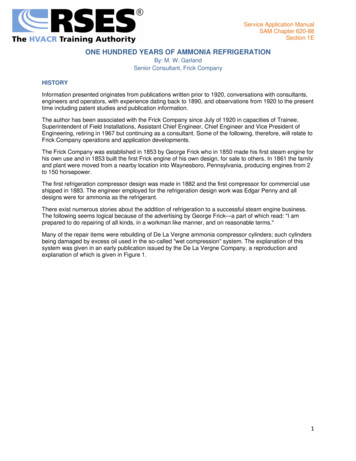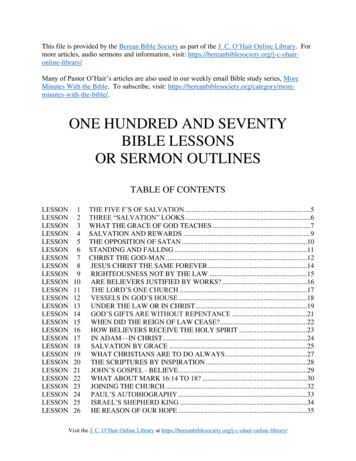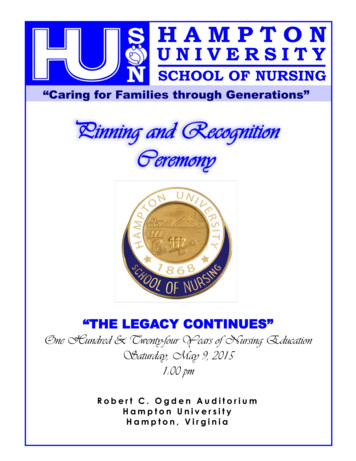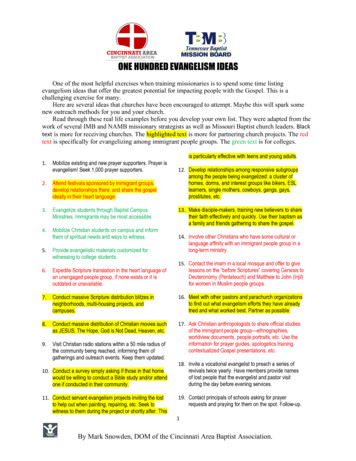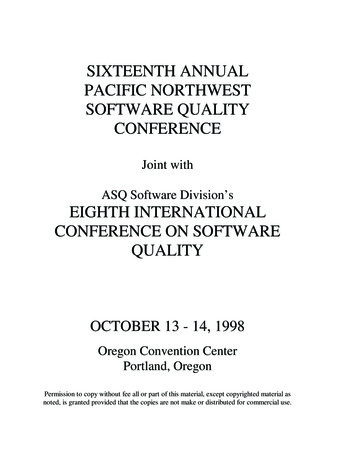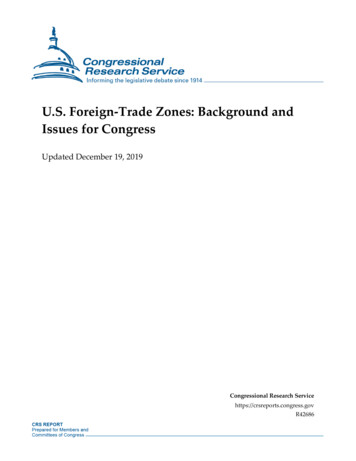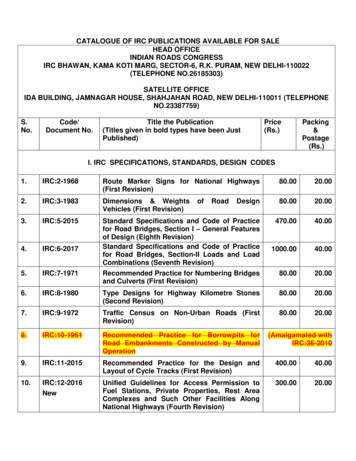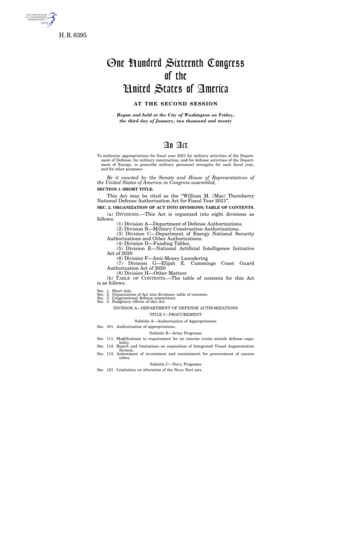
Transcription
H. R. 6395One Hundred Sixteenth Congressof theUnited States of AmericaAT T H E S E C O N D S E S S I O NBegun and held at the City of Washington on Friday,the third day of January, two thousand and twentyAn ActTo authorize appropriations for fiscal year 2021 for military activities of the Department of Defense, for military construction, and for defense activities of the Department of Energy, to prescribe military personnel strengths for such fiscal year,and for other purposes.Be it enacted by the Senate and House of Representatives ofthe United States of America in Congress assembled,SECTION 1. SHORT TITLE.This Act may be cited as the ‘‘William M. (Mac) ThornberryNational Defense Authorization Act for Fiscal Year 2021’’.SEC. 2. ORGANIZATION OF ACT INTO DIVISIONS; TABLE OF CONTENTS.(a) DIVISIONS.—This Act is organized into eight divisions asfollows:(1) Division A—Department of Defense Authorizations.(2) Division B—Military Construction Authorizations.(3) Division C—Department of Energy National SecurityAuthorizations and Other Authorizations.(4) Division D—Funding Tables.(5) Division E—National Artificial Intelligence InitiativeAct of 2020(6) Division F—Anti-Money Laundering(7) Division G—Elijah E. Cummings Coast GuardAuthorization Act of 2020(8) Division H—Other Matters(b) TABLE OF CONTENTS.—The table of contents for this Actis as follows:Sec.Sec.Sec.Sec.1.2.3.4.Short title.Organization of Act into divisions; table of contents.Congressional defense committees.Budgetary effects of this Act.DIVISION A—DEPARTMENT OF DEFENSE AUTHORIZATIONSTITLE I—PROCUREMENTSubtitle A—Authorization of AppropriationsSec. 101. Authorization of appropriations.Subtitle B—Army ProgramsSec. 111. Modifications to requirement for an interim cruise missile defense capability.Sec. 112. Report and limitations on acquisition of Integrated Visual AugmentationSystem.Sec. 113. Assessment of investment and sustainment for procurement of cannontubes.Subtitle C—Navy ProgramsSec. 121. Limitation on alteration of the Navy fleet mix.
H. R. mitations on Navy medium and large unmanned surface vessels.Fighter force structure acquisition strategy.Procurement authorities for certain amphibious shipbuilding programs.Land-based test program for the FFG(X) Frigate program.Treatment in future budgets of the President of systems added by Congress.Sec. 127. Extension of prohibition on availability of funds for Navy waterborne security barriers.Sec. 128. Report on strategy to use ALQ–249 Next Generation Jammer to ensurefull spectrum electromagnetic 2.133.134.135.136.137.138.Sec. 139.Sec. 140.Sec. 141.Sec. 142.Sec.Sec.Sec.Sec.143.144.145.146.Sec. 147.Subtitle D—Air Force ProgramsMinimum operational squadron level.Modification of force structure objectives for bomber aircraft.Minimum bomber aircraft force level.Required minimum inventory of tactical airlift aircraft.Inventory requirements for air refueling tanker aircraft.Authority to use F–35A fighter aircraft AT–1 through AT–6.F–35 aircraft gun system ammunition.Extension of limitation on availability of funds for retirement of RC–135aircraft.Modification to limitation on retirement of U–2 and RQ–4 aircraft.Modification of limitation on availability of funds for retirement of E–8JSTARS aircraft.Limitation on divestment of F–15C aircraft within the European theater.Modernization plan for airborne intelligence, surveillance, and reconnaissance.RC–26B manned intelligence, surveillance, and reconnaissance aircraft.Prohibition on funding for Close Air Support Integration Group.Required solution for KC–46 aircraft remote visual system limitations.Analysis of moving target indicator requirements and Advanced BattleManagement System capabilities.Study on measures to assess cost-per-effect for key mission areas.Subtitle E—Defense-wide, Joint, and Multiservice MattersSec. 151. Budgeting for life-cycle costs of aircraft for the Army, Navy, and AirForce.Sec. 152. Transfer of responsibilities and functions relating to electromagnetic spectrum operations.Sec. 153. Cryptographic modernization schedules.Sec. 154. Department of Defense participation in the Special Federal Aviation Regulation Working Group.Sec. 155. Integrated air and missile defense assessment.Sec. 156. Joint strategy for air base defense against missile threats.Sec. 157. Joint All Domain Command and Control requirements.Sec. 158. Expansion of economic order quantity contracting authority for F–35 aircraft program.Sec. 159. Documentation relating to the F–35 aircraft program.Sec. 160. F–35 aircraft munitions.Sec. 161. Redesign strategy for the Autonomic Logistics Information System for theF–35 fighter aircraft.Sec. 162. Briefings on software regression testing for F–35 aircraft.Sec. 163. Prohibition on use of funds for the Armed Overwatch Program.Sec. 164. Acceleration of development and fielding of counter unmanned aircraftsystems across the joint force.Sec. 165. Airborne intelligence, surveillance, and reconnaissance acquisition roadmap for the United States Special Operations Command.Sec. 166. Prohibition on divestiture of manned intelligence, surveillance, and reconnaissance aircraft operated by United States Special Operations Command.Sec. 167. Notification on efforts to replace inoperable ejection seat aircraft locatorbeacons.TITLE II—RESEARCH, DEVELOPMENT, TEST, AND EVALUATIONSubtitle A—Authorization of AppropriationsSec. 201. Authorization of appropriations.Subtitle B—Program Requirements, Restrictions, and LimitationsSec. 211. Modification of requirements relating to certain cooperative research anddevelopment agreements.
H. R. 6395—3Sec. 212. Disclosure requirements for recipients of Department of Defense researchand development funds.Sec. 213. Modification of national security innovation activities and pilot programon strengthening the defense industrial and innovation base.Sec. 214. Updates to Defense Quantum Information Science and Technology Research and Development program.Sec. 215. Establishment of Directed Energy Working Group.Sec. 216. Extension of pilot program for the enhancement of the research, development, test, and evaluation centers of the Department of Defense.Sec. 217. Designation of senior officials for critical technology areas supportive ofthe National Defense Strategy.Sec. 218. Executive agent for Autonomy.Sec. 219. National security innovation partnerships.Sec. 220. Social science, management science, and information science research activities.Sec. 221. Accountability measures relating to the Advanced Battle ManagementSystem.Sec. 222. Activities to improve fielding of Air Force hypersonic capabilities.Sec. 223. Disclosure of funding sources in applications for Federal research and development awards.Sec. 224. Governance of fifth-generation wireless networking in the Department ofDefense.Sec. 225. Demonstration project on use of certain technologies for fifth-generationwireless networking services.Sec. 226. Research, development, and deployment of technologies to support watersustainment.Sec. 227. Limitation on contract awards for certain unmanned vessels.Subtitle C—Artificial Intelligence and Emerging TechnologySec. 231. Modification of biannual report on the Joint Artificial Intelligence Center.Sec. 232. Modification of joint artificial intelligence research, development, andtransition activities.Sec. 233. Board of advisors for the Joint Artificial Intelligence Center.Sec. 234. Application of artificial intelligence to the defense reform pillar of the National Defense Strategy.Sec. 235. Acquisition of ethically and responsibly developed artificial intelligencetechnology.Sec. 236. Steering committee on emerging technology.Subtitle D—Education and Workforce DevelopmentSec. 241. Measuring and incentivizing programming proficiency.Sec. 242. Modification of Science, Mathematics, and Research for Transformation(SMART) Defense Education Program.Sec. 243. Improvements to Technology and National Security Fellowship of Department of Defense.Sec. 244. Modification of mechanisms for expedited access to technical talent andexpertise at academic institutions.Sec. 245. Encouragement of contractor science, technology, engineering, and mathematics (STEM) programs.Sec. 246. Training program for human resources personnel in best practices fortechnical workforce.Sec. 247. Pilot program on the use of electronic portfolios to evaluate certain applicants for technical positions.Sec. 248. Pilot program on self-directed training in advanced technologies.Sec. 249. Part-time and term employment of university faculty and students in theDefense science and technology enterprise.Sec. 250. National security workforce and educational diversity activities.Sec. 251. Coordination of scholarship and employment programs of the Departmentof Defense.Sec. 252. Study on mechanisms for attracting and retaining high quality talent inthe Department of 4.265.266.267.Subtitle E—Sustainable ChemistryNational coordinating entity for sustainable chemistry.Strategic plan for sustainable chemistry.Agency activities in support of sustainable chemistry.Partnerships in sustainable chemistry.Prioritization.Rule of construction.Major multi-user research facility project.Subtitle F—Plans, Reports, and Other MattersSec. 271. Modification to annual report of the Director of Operational Test andEvaluation.
H. R. 6395—4Sec. 272. Modification to Test Resource Management Center strategic plan reporting cycle and contents.Sec. 273. Modification of requirements relating to energetics plan to include assessment of feasibility and advisability of establishing a program office forenergetics.Sec. 274. Element in annual reports on cyber science and technology activities onwork with academic consortia on high priority cybersecurity research activities in Department of Defense capabilities.Sec. 275. Repeal of quarterly updates on the Optionally Manned Fighting Vehicleprogram.Sec. 276. Microelectronics and national security.Sec. 277. Independent evaluation of personal protective and diagnostic testingequipment.Sec. 278. Assessment on United States national security emerging biotechnology efforts and capabilities and comparison with adversaries.Sec. 279. Annual reports regarding the SBIR program of the Department of Defense.Sec. 280. Reports on F–35 physiological episodes and mitigation efforts.Sec. 281. Review and report on next generation air dominance capabilities.Sec. 282. Plan for operational test and utility evaluation of systems for Low-CostAttributable Aircraft Technology program.Sec. 283. Independent comparative analysis of efforts by China and the UnitedStates to recruit and retain researchers in national security-related anddefense-related fields.TITLE III—OPERATION AND MAINTENANCESubtitle A—Authorization of AppropriationsSec. 301. Authorization of appropriations.Subtitle B—Energy and EnvironmentSec. 311. Military Aviation and Installation Assurance Clearinghouse for review ofmission obstructions.Sec. 312. Readiness and Environmental Protection Integration Program.Sec. 313. Extension of real-time sound monitoring at Navy installations where tactical fighter aircraft operate.Sec. 314. Modification of authority for environmental restoration projects of National Guard.Sec. 315. Modification of authority to carry out military installation resilienceprojects.Sec. 316. Energy resilience and energy security measures on military installations.Sec. 317. Modification to availability of energy cost savings for Department of Defense.Sec. 318. Increased transparency through reporting on usage and spills of aqueousfilm-forming foam at military installations.Sec. 319. Native American lands environmental mitigation program.Sec. 320. Study on alternatives to address impacts of transboundary flows, spills,or discharges of pollution or debris from the Tijuana River on personnel,activities, and installations of Department of Defense.Sec. 321. Pilot program on alternative fuel vehicle purchasing.Sec. 322. Budgeting of Department of Defense relating to operational energy improvement.Sec. 323. Assessment of Department of Defense operational energy usage.Sec. 324. Improvement of the Operational Energy Capability Improvement Fund ofthe Department of Defense.Sec. 325. Five-year reviews of containment technologies relating to Red Hill BulkFuel Storage Facility.Sec. 326. Limitation on use of funds for acquisition of furnished energy for RhineOrdnance Barracks Army Medical Center.Sec. 327. Requirement to update Department of Defense adaptation roadmap.Sec. 328. Department of Defense report on greenhouse gas emissions levels.Sec. 329. Objectives, performance standards, and criteria for use of wildlife conservation banking programs.Sec. 330. Prizes for development of non-PFAS-containing fire-fighting agent.Sec. 331. Survey of technologies for Department of Defense application in phasingout the use of fluorinated aqueous film-forming foam.Sec. 332. Interagency body on research related to per- and polyfluoroalkyl substances.Sec. 333. Restriction on Department of Defense procurement of certain items containing perfluorooctane sulfonate or perfluorooctanoic acid.Sec. 334. Research and development of alternative to aqueous film-forming foam.
H. R. 6395—5Sec. 335. Notification to agricultural operations located in areas exposed to Department of Defense PFAS use.Sec. 336. Reporting on energy savings performance contracts.Sec. 337. Increase in funding for Centers for Disease Control Study on health implications of per- and polyfluoroalkyl substances contamination in drinking water.Sec. 338. Guaranteeing Equipment Safety for Firefighters Act of 2020.Sec. 339. Assessment of Department of Defense excess property programs with respect to need and wildfire risk.Subtitle C—Logistics and SustainmentSec. 341. National Defense Sustainment and Logistics Review.Sec. 342. Repeal of sunset for minimum annual purchase amount for carriers participating in the Civil Reserve Air Fleet.Sec. 343. Additional elements for inclusion in Navy ship depot maintenance budgetreport.Sec. 344. Clarification of limitation on length of overseas forward deployment ofcurrently deployed naval vessels.Sec. 345. Independent advisory panel on weapon system sustainment.Sec. 346. Biannual briefings on status of Shipyard Infrastructure OptimizationPlan.Sec. 347. Materiel readiness metrics and objectives for major weapon systems.Sec. 348. Repeal of statutory requirement for notification to Director of Defense Logistics Agency three years prior to implementing changes to any uniform or uniform Sec.Sec.Sec.361.362.363.364.365.Sec. 366.Sec. 367.Sec. 368.Sec. 369.Sec. 370.Subtitle D—Munitions Safety and OversightChair of Department of Defense explosive safety board.Explosive Ordnance Disposal Defense Program.Assessment of resilience of Department of Defense munitions enterprise.Report on safety waivers and mishaps in Department of Defense munitions enterprise.Subtitle E—Other MattersPilot program for temporary issuance of maternity-related uniform items.Servicewomen’s Commemorative Partnerships.Biodefense analysis and budget submission.Update of National Biodefense Implementation Plan.Plans and reports on emergency response training for military installations.Inapplicability of congressional notification and dollar limitation requirements for advance billings for certain background investigations.Adjustment in availability of appropriations for unusual cost overrunsand for changes in scope of work.Requirement that Secretary of Defense implement security and emergency response recommendations relating to active shooter or terroristattacks on installations of Department of Defense.Clarification of food ingredient requirements for food or beverages provided by the Department of Defense.Commission on the naming of items of the Department of Defense thatcommemorate the Confederate States of America or any person whoserved voluntarily with the Confederate States of America.TITLE IV—MILITARY PERSONNEL AUTHORIZATIONSSubtitle A—Active ForcesSec. 401. End strengths for active forces.Sec. 402. Revisions to permanent active duty end strength minimum levels.Sec. 403. Modification of the authorized number and accounting method for seniorenlisted personnel.Subtitle B—Reserve ForcesEnd strengths for Selected Reserve.End strengths for Reserves on active duty in support of the Reserves.End strengths for military technicians (dual status).Maximum number of reserve personnel authorized to be on active dutyfor operational support.Sec. 415. Separate authorization by Congress of minimum end strengths for nontemporary military technicians (dual status) and end strengths for temporary military technicians (dual status).Sec.Sec.Sec.Sec.411.412.413.414.Subtitle C—Authorization of AppropriationsSec. 421. Military personnel.
H. R. 6395—6TITLE V—MILITARY PERSONNEL POLICYSubtitle A—Officer Personnel PolicySec. 501. Authorized strengths of general and flag officers on active duty.Sec. 502. Temporary expansion of availability of enhanced constructive servicecredit in a particular career field upon original appointment as a commissioned officer.Sec. 503. Diversity in selection boards.Sec. 504. Requirement for promotion selection board recommendation of higherplacement on promotion list of officers of particular merit.Sec. 505. Special selection review boards for review of promotion of officers subjectto adverse information identified after recommendation for promotionand related matters.Sec. 506. Number of opportunities for consideration for promotion under alternativepromotion authority.Sec. 507. Mandatory retirement for age.Sec. 508. Clarifying and improving restatement of rules on the retired grade ofcommissioned officers.Sec. 509. Repeal of authority for original appointment of regular Navy officers designated for engineering duty, aeronautical engineering duty, and specialduty.Sec. 509A. Permanent programs on direct commissions to cyber positions.Sec. 509B. Review of Seaman to Admiral–21 program.Subtitle B—Reserve Component ManagementSec. 511. Temporary authority to order retired members to active duty in high-demand, low-density assignments during war or national emergency.Sec. 512. Expansion of Junior Reserve Officers’ Training Corps Program.Sec. 513. Grants to support STEM education in the Junior Reserve Officers’ Training Corps.Sec. 514. Permanent suicide prevention and resilience program for the reserve components.Sec. 515. Modification of education loan repayment program for members of Selected Reserve.Sec. 516. Inclusion of drill or training foregone due to emergency travel or duty restrictions in computations of entitlement to and amounts of retired payfor non-regular service.Sec. 517. Quarantine lodging for members of the reserve components who performcertain service in response to the COVID–19 emergency.Sec. 518. Direct employment pilot program for certain members of the reserve components.Sec. 519. Pilot programs authorized in connection with SROTC units and CSPI programs at Historically Black Colleges and Universities and minority institutions.Sec. 519A. Report regarding full-time National Guard duty in response to theCOVID-19 pandemic.Sec. 519B. Study and report on National Guard support to States responding tomajor disasters.Sec. 519C. Report on guidance for use of unmanned aircraft systems by the National Guard.Sec. 519D. Study and report on ROTC recruitment.Subtitle C—General Service Authorities and Correction of Military RecordsSec. 521. Increased access to potential recruits.Sec. 522. Sunset and transfer of functions of the Physical Disability Board of Review.Sec. 523. Honorary promotion matters.Sec. 524. Exclusion of official photographs of members from records furnished topromotion selection boards.Sec. 525. Report regarding reviews of discharges and dismissals based
Sec. 142. Modernization plan for airborne intelligence, surveillance, and reconnais-sance. Sec. 143. RC–26B manned intelligence, surveillance, and reconnaissance aircraft. Sec. 144. Prohibition on funding for Close Air Support Integration Group. Sec. 145. Required solution for KC–46 aircraft rem
